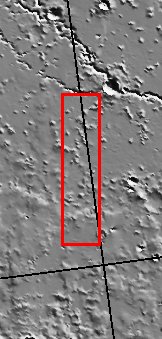Nepenthes Mensae
Caption:

(Released 23 July 2002)
This image shows relatively smooth plains dotted with some craters and stepped mesas and knobs. This image is located near the highland-lowland boundary scarp in a region called Nepenthes Mensae. These eroded mesas and knobs commonly display a stepped topography. Some of these mesas and knobs have flat ledges partway up their slopes. These ledges are made of more resistant layers of rock and are the last remnants of layers that once were continuous across this entire region. Erosion has completely removed these layers in most places, leaving behind only the small isolated mesas and knobs. This one band IR (band 9 at 12.6 microns) image shows some minor bright and dark textures, which are primarily due to differences in the abundance of rocks on the surface. No significant variation in thermophysical properties of surface materials is visible in this image. The relative uniformity of the surface properties suggests that a process (or processes) has mantled or homogenized the surface layer. The mantling layer in this region is most likely dust. The relatively cool (dark) regions during the day are rocky or indurated materials whereas fine sand and dust are warmer (bright). The brightness levels show daytime surface temperatures, which range from about minus 39 degrees to minus 17 degrees Celsius (minus 38 degrees to plus 1 degrees Fahrenheit). Many of the temperature variations are due to slope effects, with sun-facing slopes warmer than shaded slopes. The dark rings around several of the craters are due to the presence of rocky (cool) material ejected from the crater (best seen near bottom of image).
Daytime temperature variations are produced by a combination of topographic (solar heating) and thermophysical (thermal inertia and albedo) effects. The surface morphologies seen in THEMIS daytime IR images due to topographic heating are similar to those seen in previous imagery and MOLA topography.
Cataloging Keywords:
| Name |
Value |
Additional Values |
| Target |
Mars |
|
| System |
|
|
| Target Type |
Planet |
|
| Mission |
2001 Mars Odyssey |
|
| Instrument Host |
Mars Odyssey |
|
| Host Type |
Orbiter |
|
| Instrument |
Thermal Emission Imaging System (THEMIS) |
|
| Detector |
|
|
| Extra Keywords |
Crater, Dust, Grayscale, Infrared, Thermal |
| Acquisition Date |
|
| Release Date |
2002-07-24 |
| Date in Caption |
2002-07-23 |
|
| Image Credit |
NASA/JPL/Arizona State University |
| Source |
photojournal.jpl.nasa.gov/catalog/PIA03904 |
| Identifier |
PIA03904 |


